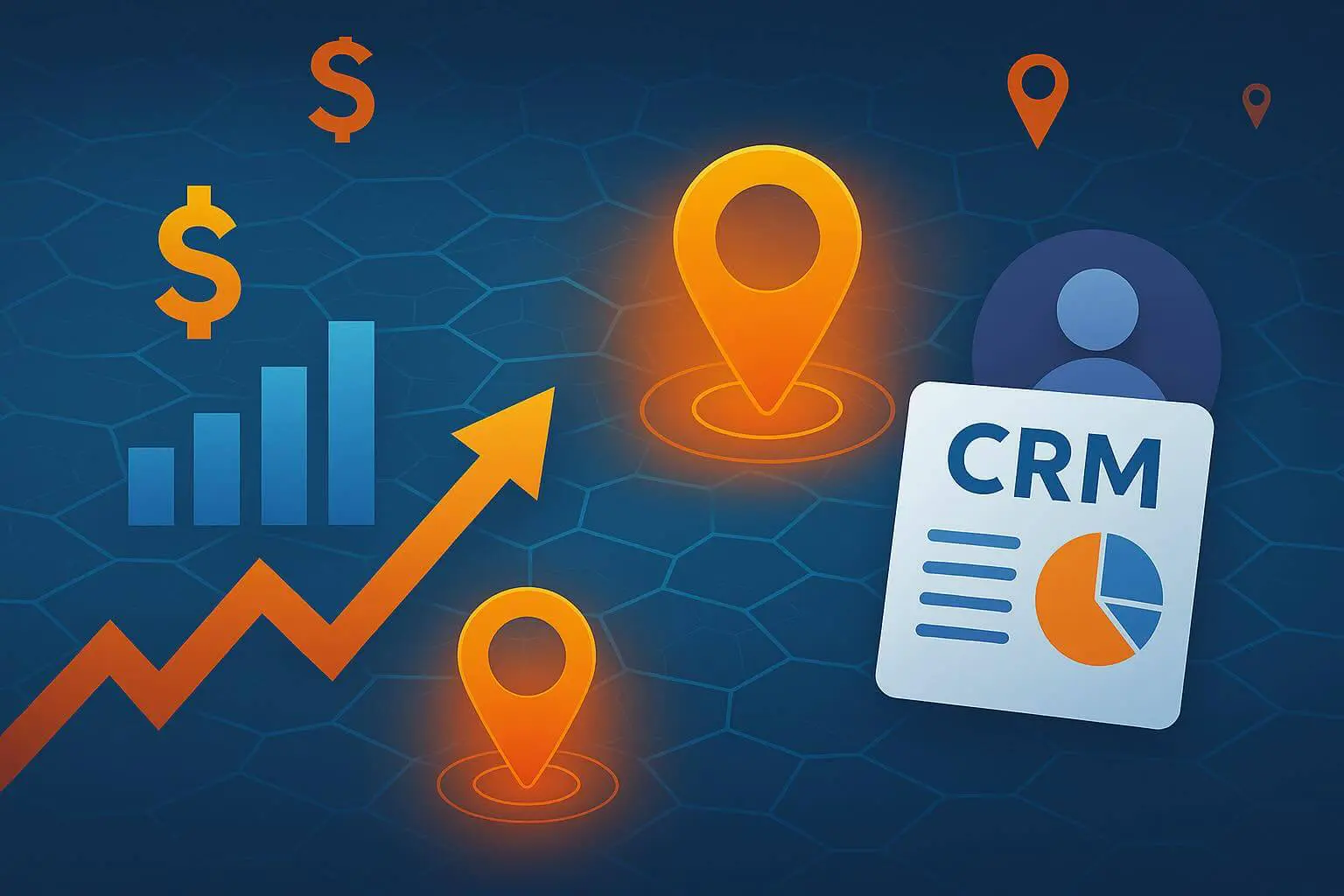
What Is Data Driven Marketing? 4 Key Strategies for Customer Engagement
Let me preface here with the fact that I SWEAR this blog is going to cover what data-driven marketing is and why it’s so powerful.
However, it’s critical I first start out by going on a short tangent about human behavior and psychology– since we’re also going to be talking about effectively engaging your ideal customers.
Let me also preface that I’ve never been formally educated in psychology, specifically. I’m not a psychologist nor do I claim to be. I’m more of a “self-taught enthusiast” you might say. (You might also say “unironically borderline obsessed” with the subject.)
Is Human Behavior Predictable?
I find it utterly fascinating how human behavior and the way it can be influenced, whether consciously or subconsciously, by even the tiniest little things. This makes sense as to why online marketing, and especially branding, has become my passion and chosen career.
Understanding how people think and why they do what they do is essential if you’re going to make any kind of influencing your targeted consumer behavior or any shaping of brand perception.
You can check out where I geeked out on how you can influence human behavior using Color Psychology for Web Design and Branding in a previous blog.
According to Dr. Charles Tatum, head of the Master of Arts in Human Behavior program at National University, human behavior is motivated by biology, the environment in which someone is immersed, and the interaction of these two factors as well.
“Researchers cannot make predictions about human behavior in the same way a physicist can make predictions in a lab. Like the weather, these are complex patterns and the weatherman is never 100 percent accurate. But, in theory, if scientists had all the information about the nature and nurture motivations, we could predict behavior with accuracy.”
SO… based on that school of thought:
Provided you had enough informative data to predict a behavioral outcome, you can in turn influence a behavioral outcome in your favor.
Persuading & Influencing Consumer Decisions
Understanding what consumers want and need (and ideally before they even realize it) is an ongoing imperative for marketers, and makes us all aspiring psychologists at heart.
“The Decoy Effect” is one of my favorite examples of human behavior-influencing principles because it’s just so subtly simple.
Also called the asymmetrical dominance effect, the decoy effect is a truly fascinating phenomenon. How does it work?
An almost perfect explanation is given in a famous TED talk by Dan Ariely called, “Are We in Control of Our Own Decisions?”
According to Ariely, a decoy can change our subconscious behavior when we’re faced with choosing between alternatives that are, more or less, equally attractive options.
You’ll often see this behavior frequently capitalized on in pricing models where one price point is intentionally included in order to lure you into choosing the most expensive option.
A Real-World Example
To illustrate using a real-world marketing example, Dan in the TED Talk above describes an ad he had recently seen put out by The Economist outlining their newest subscription packages offering 3 options:
- Online subscription for $59
- Print subscription for $125
- Both the online and print subscriptions for $125
If I hadn’t already prefaced with the fact there were about to be marketing psychology shenanigans afoot, at first glance, you may have thought that 2nd option to be useless.
Why would people even choose option 2 when they could get BOTH 1 & 2 for the same price?
But it’s actually a prime example of utilizing a decoy pricing strategy. With only options 1 and 2 by themselves, it would be an easily innate decision to just go with the 1st and cheaper option.
But when you add in the 3rd combo option, SEEMINGLY IRRATIONALLY AT THE SAME PRICE as the 2nd option, the 2nd option then becomes the less attractive version of option 3– and option 3 now looks like a steal and the obvious choice. You’d be wasting money choosing any other option!
“People buy on emotion and justify with logic.”
Yes, at face value this all sounds very manipulative, and, to be honest, it most definitely is. But let’s face it – humans are emotion-based decision-makers by nature. According to Harvard professor Gerald Zaltman, 95% of our purchasing decisions take place unconsciously.
His research supporting this idea is so impactful because it helps us realize that we human beings are not as logical as we might imagine. We as consumers are not as savvy as we think we are, and understanding this has huge implications for marketing, sales, and branding.
You may have heard it said before that people make purchasing decisions emotionally and then justify those decisions to themselves logically. But what does that mean?
The CEO of Insight Demand, Michael Harris, explained it pretty well when he said:
“I now have a better understanding as to why this expression created mixed feelings for me. I discovered, for example, that people do not simply decide emotionally. The decision to buy is made subconsciously, and these subconscious decisions are based on a deeply empirical mental processing system that follows a logic of its own. Our subconscious/intuitive decision to buy is then communicated to the conscious mind via an emotion. The conscious mind then searches for rational reasons, and that’s how we complete the circle: We justify our emotional signals to buy with logical reasons. Phew, the illusion is now complete that the conscious mind that we identify with is in control so we can feel safe and secure.”
Predicting Where & What Will Influence Customers’ Decisions
It’s pretty safe to say we all know what we’re getting into when we go in search of a product, service, or local business to help fulfill a perceived need or solve a problem we may have.
Most of us have come to expect to be pushed and educated on why we should choose them as a solution and why they’re the better/cheaper/faster option… in other words, marketed to.
The digital and social media age has obviously brought a worldwide reach to even the smallest of startups to take advantage of. It’s also provided the ability for laser-focused targeting accuracy.
However, influencing consumers with marketing and advertising has obviously shifted dramatically and drastically away from the old-school, Mad Men approach of flashy and pandering slogans. Most business owners are fully aware that sleazy tactics don’t equal long-term business growth.
But hold on a minute- Before you can just go full gung-ho on what you think the best new online marketing strategy for your business should be… and expect to see any kind of success, there are a few prerequisites you need to understand.
You Gotta Get Up Close and Personal
Not only do you need to know/predict what your ideal customers think they need, what they are scared of, and what emotionally motivates them to make decisions…
You also then need to make sure that you’re engaging them with a personalized experience.
The majority of today’s consumers are more likely to engage with brands that personalize their experience.
91% of consumers are more likely to shop with brands who provide relevant offers and recommendations (source).
80% of customers are more likely to purchase a product or service from a brand who provides personalized experiences (source).
72% of consumers in 2019 only engage with marketing messages that are customized to their specific interests (source).
80% of those who classify themselves as frequent shoppers say they only shop with brands who personalize their experience (source).
BUT…
Where are your ideal customers currently and actively going to look for solutions?
What’s working and what’s not working in your industry and for your company?
What online avenues should you be throwing boatloads of money at… and which should you cease and desist?
How can you even go about predicting what your customers will love/hate/interact with or even simply grab their attention?
It may sound like you almost have to be psychic… but you don’t. Enter, data driven marketing.
What is Data Driven Marketing for Customer Engagement?
Data-driven marketing refers to strategies that are built on insights pulled from the analysis of big data, collected through consumer interactions and engagements, to form predictions about future behaviors.
It can be thought of as an integral piece of the puzzle that helps you get closer to providing a truly personalized experience for your potential customers.
Utilizing data driven approaches to decision-making is how you are going to see the most return on investment (ROI) when it comes to making marketing moves. But don’t just take my word for it:
Companies with data-driven marketing are six times more likely to be profitable year-over-year. (source)
75% of companies see increased engagement when they use data-driven marketing. (source)
Businesses with data-driven strategies see five to eight times as much ROI as businesses without. (source)
It is next to impossible to launch any SUCCESSFUL marketing campaign based on our own emotional “gut feelings.”
Data is one of your most valuable marketing and business growth resources. But, unlike our human decisions, data isn’t emotional. Data is cold hard logical facts. It’s undeniable truth and proof in numbers.
That’s why data driven marketing strategies are so powerful. They should be the fundamental driver for ALL your business efforts and marketing shift decisions.
There’s a multitude of ways to engage with your ideal customers based on data. Still, for the purpose of this blog, I really wanted to narrow it down to just a few of the most impactful ways you can start implementing a data driven marketing approach in order to engage your ideal customers, right now.
TIP #1: Adopt a CRM and Marketing Automation Platform
Making smart marketing decisions based on your customer data is going to require the integration and consolidation of your data from a myriad of online sources.
It’s the easiest and quickest way to get a real holistic view of your customers, their behavior, marketing campaign ROI, and so much more.
What is a CRM?
A CRM is an organizational software that is primarily sales-focused. It serves as a tool for tracking marketing and sales communications and housing a ton of data on prospects, leads, and customers. It tracks the status of each contact with every touchpoint throughout its entire lifecycle.
Think of it as your business’ “little black book”… but on some crazy powerful digital steroids.
The Rise of the CRM Birthed Data Driven Marketing
Technically, it would be more accurate to say that the creation of CRM (customer relationship management) software almost immediately introduced marketing automation software onto the scene – which then, in turn, gave birth to data driven marketing strategies.
CRM and Marketing Automation software systems are basically an “old married couple” at this point, although the two can function as separate platforms. Together, they allow you to deliver personalized customer experiences, acquire and retain customers, and gain new customer-centric insights.
What Is Marketing Automation?
Marketing automation software allows businesses to automate repetitive tasks such as sending emails, maintaining social media, tracking website interactions, and handling various other marketing tasks.
It also centralizes almost all of the features and functions you need to track the performance of your business. But, it’s so much more than just a “repetitive task machine.”
Utilizing marketing automation correctly allows you to:
- Generate more leads by identifying anonymous web visitors and capturing them with forms, so your sales funnel stays full.
- Increase the number of qualified leads by nurturing all leads with personalized content.
- Drive more sales by identifying sales-ready leads for the sales team, and helping them follow up as fast as possible.
- Improve up-selling and cross-selling by developing and retaining existing customers.
- See comprehensive ROI for every marketing tactic by tracking the entire sales process from end to end.
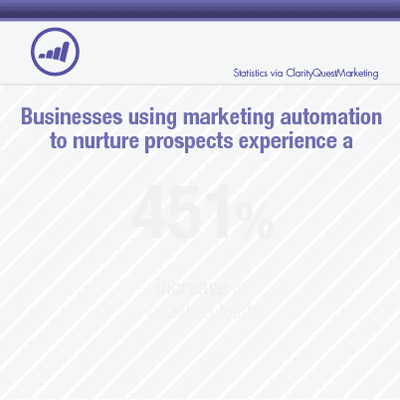
I could go on and on about marketing automation because there’s just an overabundance of strategies and best practices that I could cover here– but we’ll save that for another time/blog.
Bottom line:
Marketing automation is a powerful tool to have in your arsenal, delivers incredible ROI, and modern digital times almost necessitate its use for hyper-personalization.
TIP #2: Utilize Customer Insight Tools
There are lots of ways to track your customers’ behaviors online. You may already have accumulated a mountain of information already on what they do, where they do it, how they do it, how long they do it, etc…
But does your business have the data points on the WHY? What better way to understand how your ideal customers think than to literally just ask them?!?
Survey & Feedback Tools
Easy-to-use survey tools like Google Surveys and the popular SurveyMonkey allow you to craft carefully chosen questionnaires, target consumers for answers by specific demographics, and turn those responses into actionable insights.
These surveys provide you with near-instant feedback for many market research use cases: ad testing, product development, content marketing, brand tracking, consumer behavior, investment research, crisis management, and more.
But it’s not just your potential customers you can gain valuable insight from – what about your current customers? What are they happy about? What would they like to see a change in your business?
By creating surveys for your current customers, you are able to find out exactly what you’re doing right, what to keep doing, and what to start doing.
User Behavior Heatmaps & Methodology Tools
A Heatmap is a ridiculously powerful tool to gain insight into just exactly what your visitors are doing on your website and its pages–literally. A Heatmap tool, like the popular software Hotjar records where they click or tap, how far they scroll, what they look at or ignore, etc… in real time.
Plus it’s presented in a graphical way to make it super easy to understand. (Think, “Predator Vision” like in the movie…)
If you’re able to see what they are interacting with and what is grabbing attention, you do more of that. If something important is being ignored, then you know to change that.
By fine-tuning landing pages, messaging, and creative elements, you’re optimizing your conversions and growth. See how valuable that insight can be
Momma always said,
“You never get a second chance at a first impression…”.
Did you know that it takes only about 50 milliseconds for users to form an opinion about your website that determines whether they like your site or not… and whether they’ll stay or leave. (source)
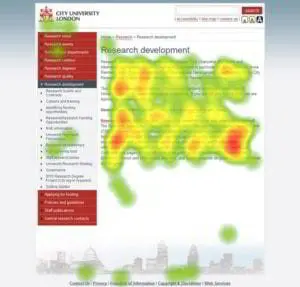
Don’t think that’s true? Check this out:

Imagine the two sites in the graphic above had the same furniture for sale, the same pricing, and delivered to the same geographical area in the same amount of time.
If you were a motivated buyer and shopping around for new quality furniture, which website do you think you’d scroll and click around to learn more on… and which would you immediately abandon ship and forget?
But even more so than that, WITHOUT LOOKING AGAIN, what are the top three things you remember from the more aesthetically pleasing site?
What about the less aesthetically pleasing site? Did it unconsciously cause you to feel that their furniture would be of inferior quality?
Get “Outrospective” With Insight Tools
You see your website just about every day- and may even have had a hand in designing it. Sometimes it’s near impossible to look at something with an objective eye if you’ve had a hand in its creation. A parent’s love is blind.
- So how can you discover what first impression you’re really making on your website-visitor newbies?
- Are you sure they’re getting an instant understanding of your most important message or directed to your desired next-step actions?
Well, there’s a multitude of amazingly helpful consumer insight tools out there, including one we love called: UsabilityHub!
This software allows you to run specific tests to validate design/creative directions and discover if they are going to be as impactful as you think they are going to be (or currently are) with your target audience. Talk about making super-precise data-driven marketing decisions!
The Five-Second Test Tool
One of the testing platforms we use a lot here is the five-second test. This shows the viewer a design or a snapshot of a landing page for just 5 seconds… and then has them answer a few short, targeted questions of your choosing.
Insight gleaned from the results allows you to accurately optimize the clarity of your designs and layout, messaging, and creative elements by measuring people’s recall and first impressions – and thus eliminate the guesswork and loads of wasted A/B testing time… and in most cases the wasted money.
What’s fun about these tools is that when results come back, even the most “top-of-their-game” marketers are surprised by the findings.
And what’s even more fun is when you’re not the primary decision-maker on an end design, or you’re trying to persuade a design change… you can walk into a presentation like a badass with real-life, ideal customer data to back you up.
TIP #3: Create Behavior Triggered Emails
Before I dig into what a triggered email is and how to use it effectively, here are a few stats that illustrate why you’d be a dummy not to use automation for your email campaigns:
Automated emails get 86% higher open rates, produce a 196% increase in click-through rates, and generate 320% more revenue than standard promotional emails. (source)
Personalized emails deliver 6x higher transaction rates. (source)
Utilizing a CRM and Marketing Automation platform like in the example above facilitates and automates email campaigns for you based on predefined list segments.
Triggered emails are sent out based on a customer’s very own online behavior. It’s so successful because it’s BOTH timely and highly relevant. That’s a combo for purchase persuasion success. This automated process is also called behavioral marketing automation. Here are two very common, yet very effective behavioral trigger email examples:
The Onboarding Automated Email
This is usually a welcome email that has the sole purpose of enticing the user to start clicking and interacting with you as quickly and as fluidly as possible once they’ve entered information on your site.
You’ve heard the idiom “strike while the iron’s hot?” That’s an old blacksmith saying that literally means: strike a hot piece of metal before it cools and is still hot enough to be shaped.
If you’ve got a hot lead on your hands, hit them with something to shape their buying decision!
Here’s a great example using Ann Taylor’s where they include helpful links, messaging that conveys you are part of an exclusive insider’s club, and most importantly, a coupon for extra motivation to buy.
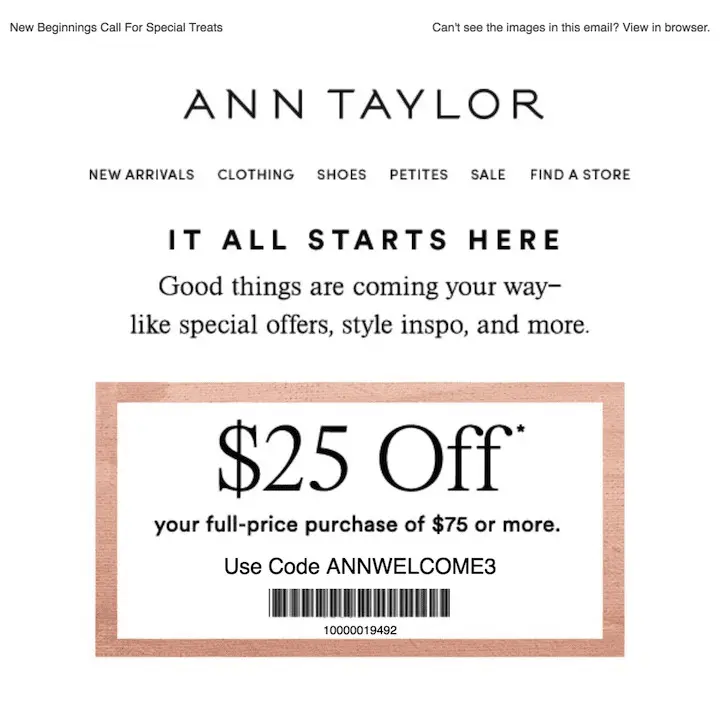
The Abandoned Cart Automated Email
Sometimes, your first-time visitors need a little more convincing before they open up their hearts… and their wallets. If you’re a modern consumer with mild-to-moderate social anxiety combined with frequent bouts of insomnia like me, you may prefer to do most of your shopping online. (and in the wee hours of the morning?)
But did you know that around 75% of shoppers end up abandoning their carts?
Even though most usually plan to come back later to complete their purchase, a majority just don’t – it’s easy to forget when it’s not in front of your face. (or if you end up finally falling asleep with your phone on your face before you complete their purchase and then get busy and forget all about it…like me)
Recent Salesforce data shows that a whopping 60% of shoppers returned to make a purchase within 24 hours of receiving personalized emails after abandoning their shopping carts.
That’s a huge recovery of what was once potentially lost revenue.
Amazon is hugely successful with this and definitely a fine leader to follow. It’s a simple, friendly reminder to finish what you started.
But these aren’t just strategies eCommerce sites alone can use to their advantage. Test and analyze how your visitors and customers are interacting with your site and come up with clever ways to keep your business and services always at top of minds and in their faces.
What Is the Rule of Seven?
The Rule of Seven is an old (borderline ancient) marketing adage that states that a potential customer needs to see or hear your marketing message at least seven times before they take action and buy from you.
It’s not always a hard-set magic number of exactly seven, but the important thing to understand here is the underlying message behind it:
People only buy from whom they trust. Trust is earned over time with consistent and positive interactions.
TIP #4: Shape your Content Strategy Around Ideal Customer Search Intent
How powerful would your content marketing game be if you could psychically predict what problems and questions your ideal customers have– and be there with their personalized answers, ready and waiting for them when they search for help?
One of the biggest challenges companies who blog face today is consistently generating topic ideas that their ideal customer actually wants to engage with.
It’s incredibly important to ensure you’re always choosing your targeted keywords based on strong SEO data, but one of the most pivotal factors in ranking today is also choosing and using topics/phrases based on USER INTENT.
It‘s more important that your content and pages address the problem your potential customers intended to solve, other than simply just including trending keywords. Luckily, it’s all a heck of a lot easier with data driven tools.
Google Trends
Utilizing Google Trends is an incredibly practical way to find out what types of topics people are searching for, what phrases and terms they’re using, and especially when searches are spiking. (And you don’t even have to have a google account to use it.)
When one specific search term spikes in relation to other searches, Google classifies it as a “trend” and stores an unfathomable amount of data on it all.
Some core features of using Google trends are:
- Obviously being able to stay on top of the latest, and predictably historic search trends.
- Conduct research on a keyword topic’s popularity over time.
- Segment your results according to web, image, news, and YouTube searches as well as by specific periods of time or regions.
- Discover other closely related keyword searches and topic ideas.
At the moment of writing this blog, here’s a quick snapshot of what was currently trending, just for fun:
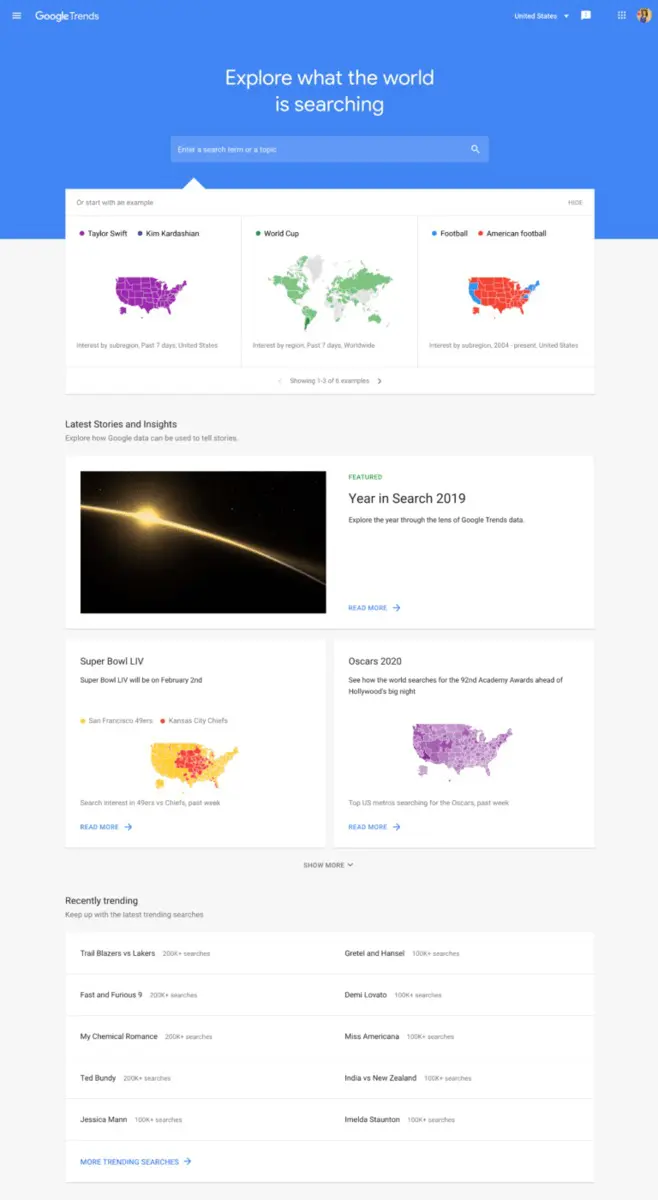
Google Auto-complete
It’s probably not a shocker that Google has an entire suite of keyword search and data tools available.
One surprisingly underutilized, but in hindsight-ly obvious one is its autocomplete prediction feature in its search bar. Talk about psychic abilities…
In Google’s official explanation, they say: “Autocomplete predictions are possible search terms… The search queries that you see as part of Autocomplete reflect what other people are searching for and the content of web pages.”
As you start to type a question in the search bar, Google autocompletes your question with options dynamically as you add more words.
Now, this doesn’t give you an entire scope of the SEO viability or competition for a term or phrase but it does give you accurate relevance queues.

Google’s Related Searches
Here’s a third, almost insider-knowledge-type Google trick:
Check out the bottom of the page of your search results. They can be a literal treasure trove of content ideas.
The Autocomplete feature offers topical predictions based on what’s trending in searches.
Related Searches offers you closely related suggestions on what others are searching for. However, they don’t necessarily have to include the original query.
For example, I started a search with: “can dogs…” and chose the first autocomplete choice, “can dogs eat grapes.”
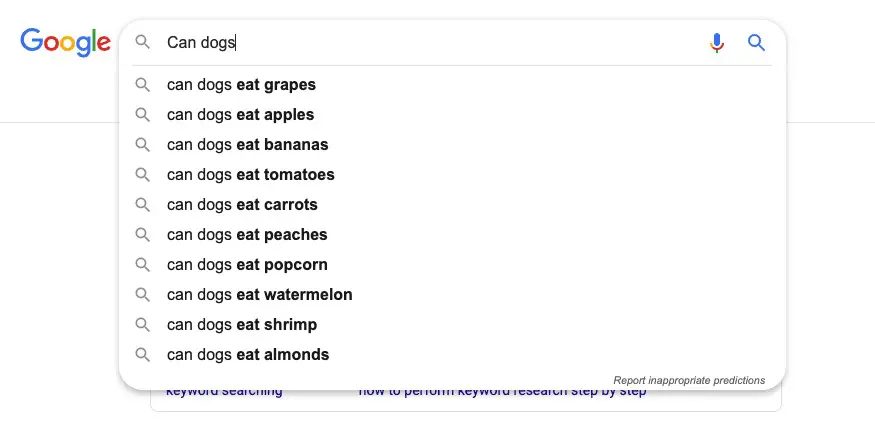
Then scrolling down, Google presented a bunch of highly relevant, and closely, related searches.
For example: “toxic food for dogs,” “what fruit can dogs eat,” and the very specific, “my dog ate 10 grapes.”
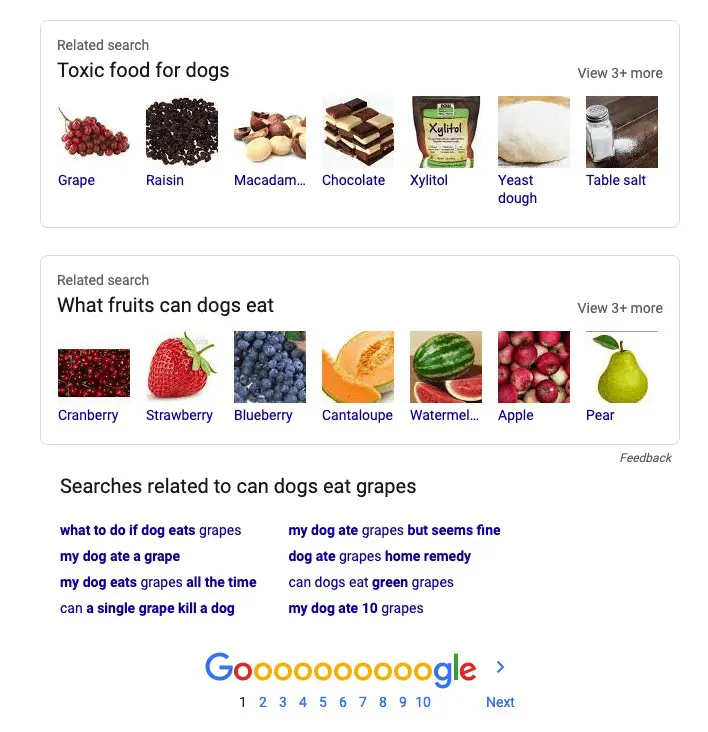
Social Media
You shouldn’t overlook major social media channels. They allow you to gain insight into what is both trending and relevant to your customer base.
The search functions and trending graphs show both currently and historically what real people are having conversations about.
Check out:
- X’s “#Explore” search functionality is located in the left sidebar of your profile
- YouTube’s “🔥 Trending” feed and search menu item
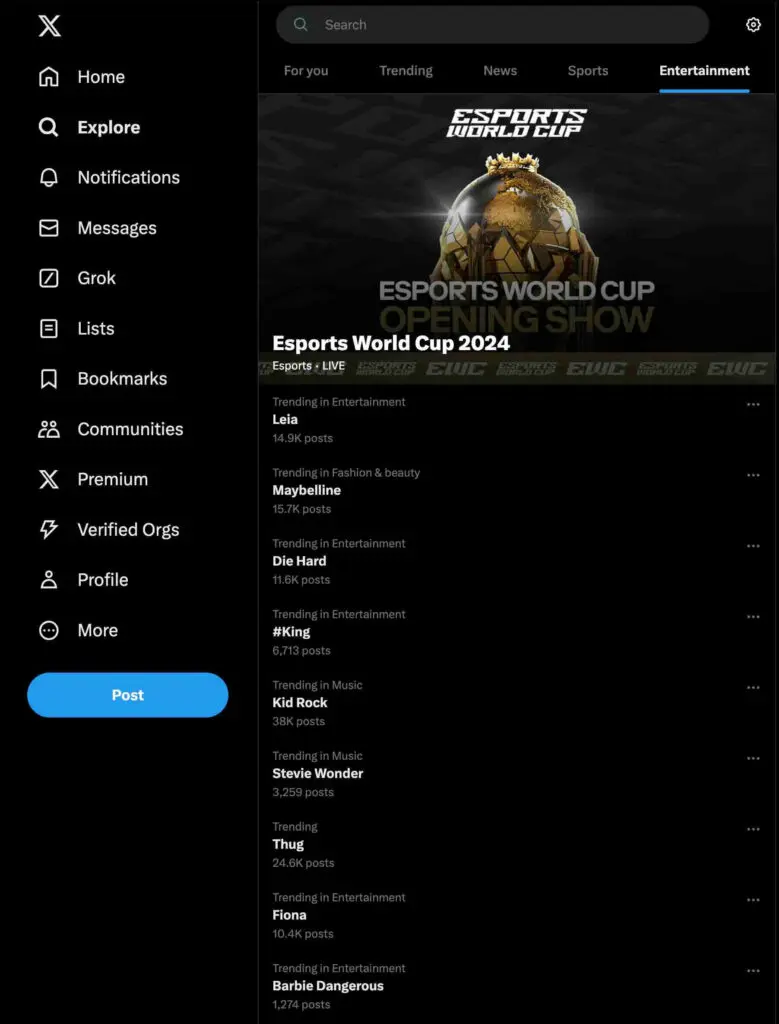
The Bottom Line When Taking a Data-Driven Approach
I feel like I’ve only just scratched the surface of this entire topic. It’s so complex with so many nuances and moving parts involved. There’s just an absolute wealth of information on it. I guess the most important takeaway I want you to remember from all of this is:
You can gather all the data and numbers and track all the KPIs you can get your hands on–- and that’s absolutely critical.
But it’s equally as important to develop the right people and hire the right teams. You need people with the skill sets to actually understand and utilize the data you collect.
They need to make the correct decisions, tweak operations, and drive business forward using the appropriate, emotionally targeted messaging.
Basically, you need to approach your entire marketing strategy as a symbiotic relationship between emotion and logic.
Marketing success comes from combining techniques and tools with logical data and human behavioral science to better understand and engage your customers with personalized messaging.
Model your marketing strategy after Kirk and Spock. 🖖 They’re just not as effective without each other.

